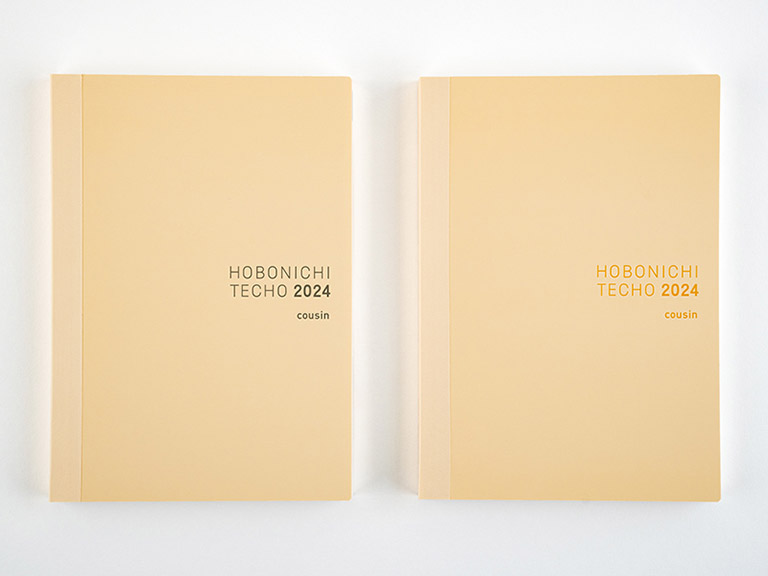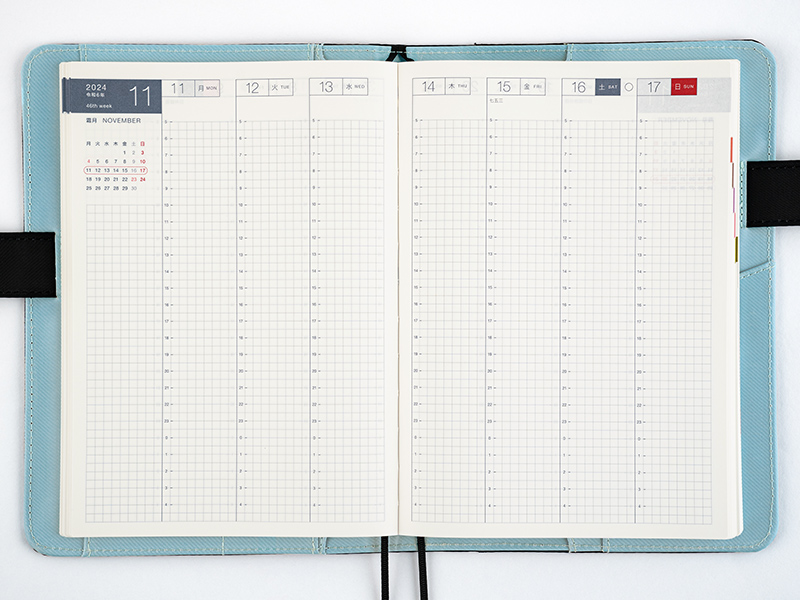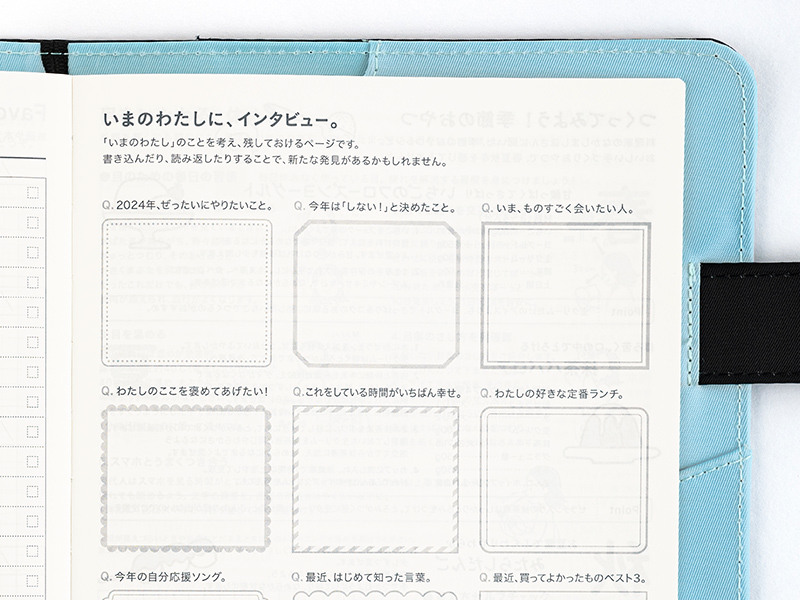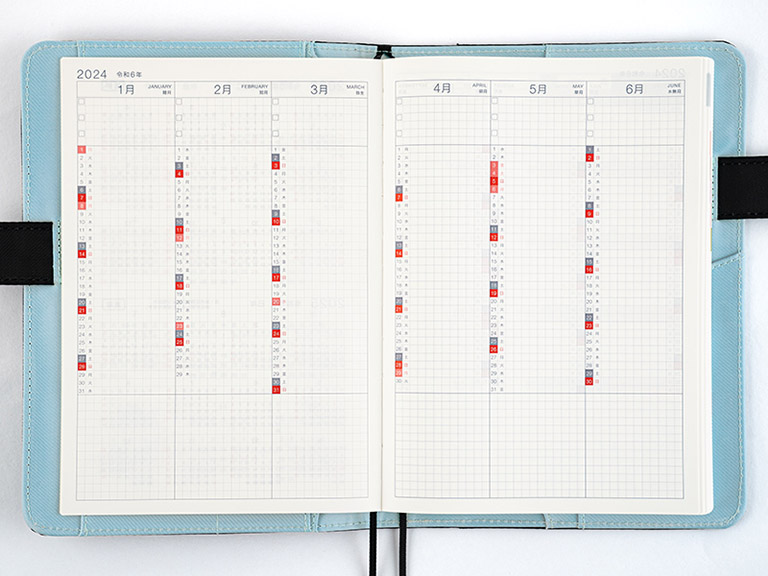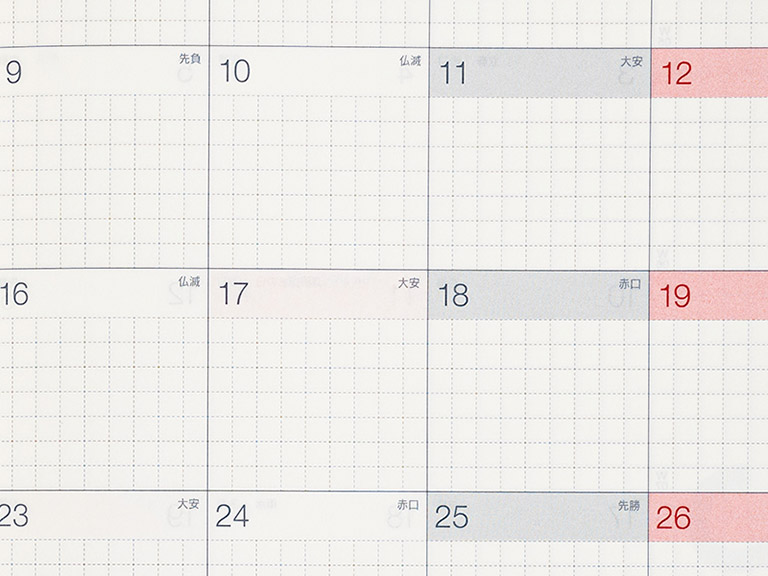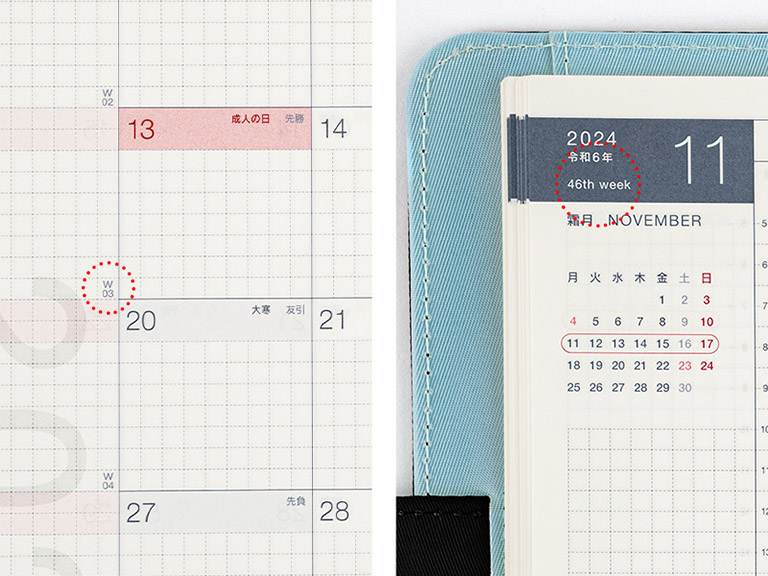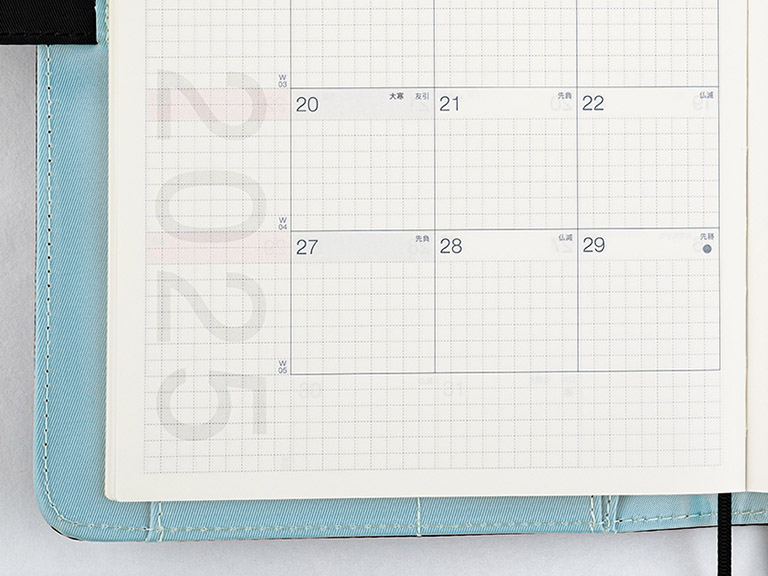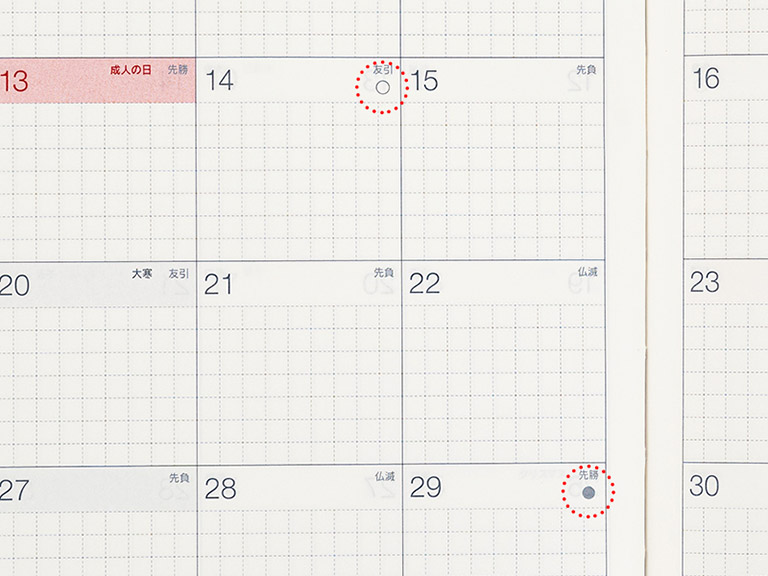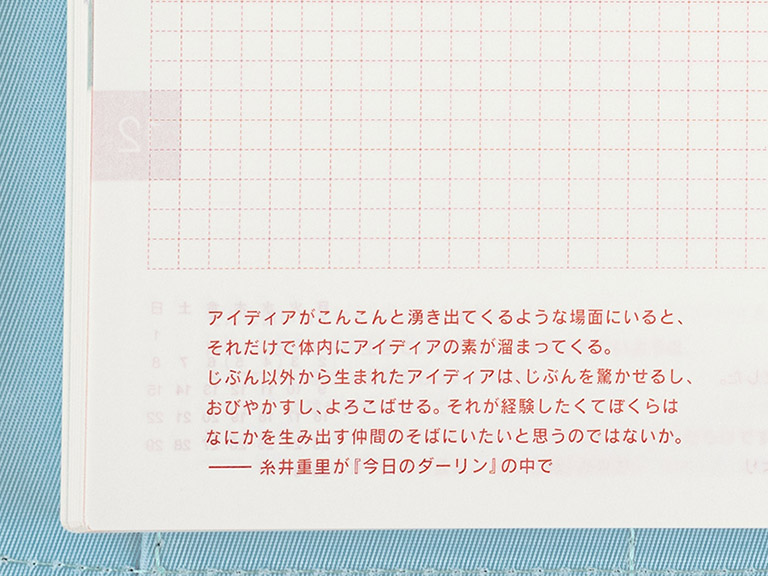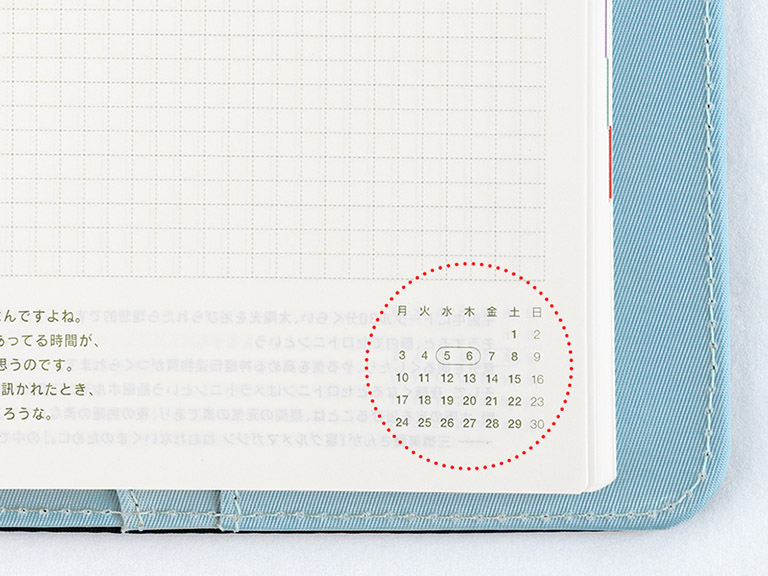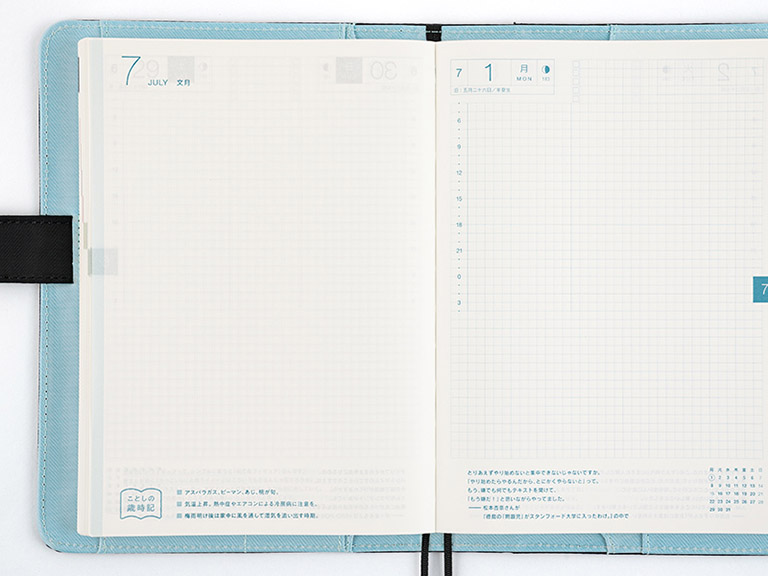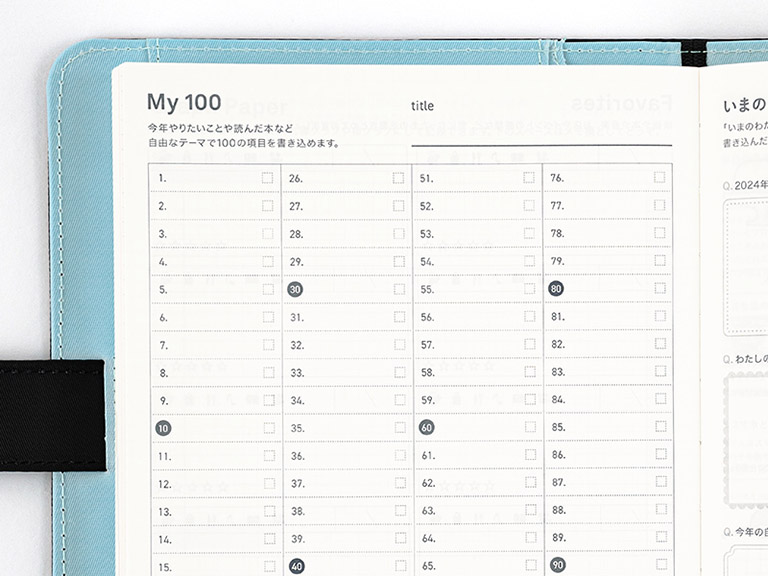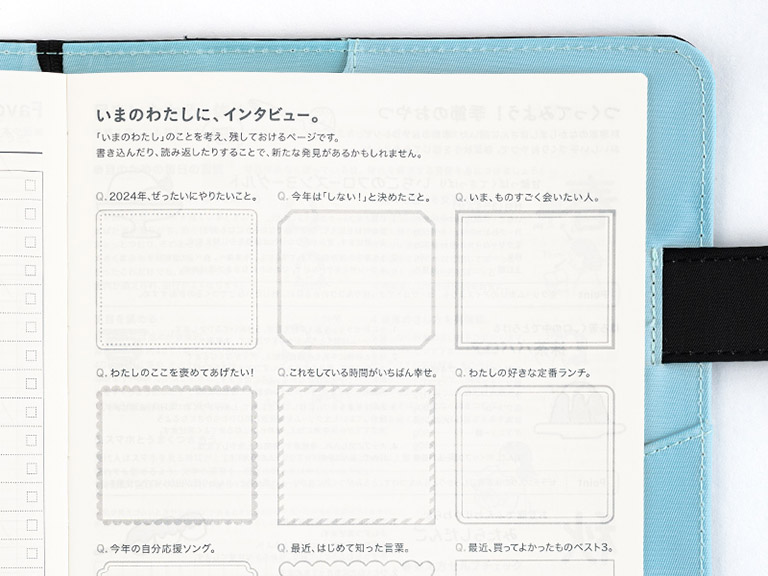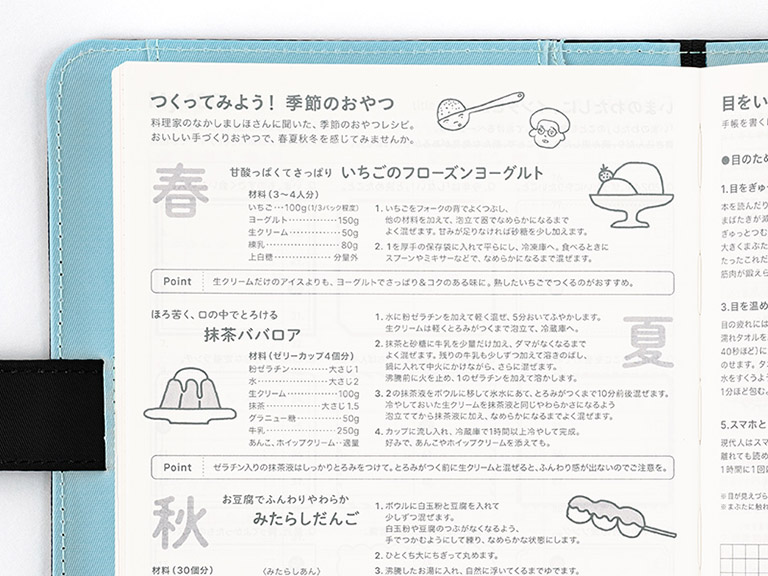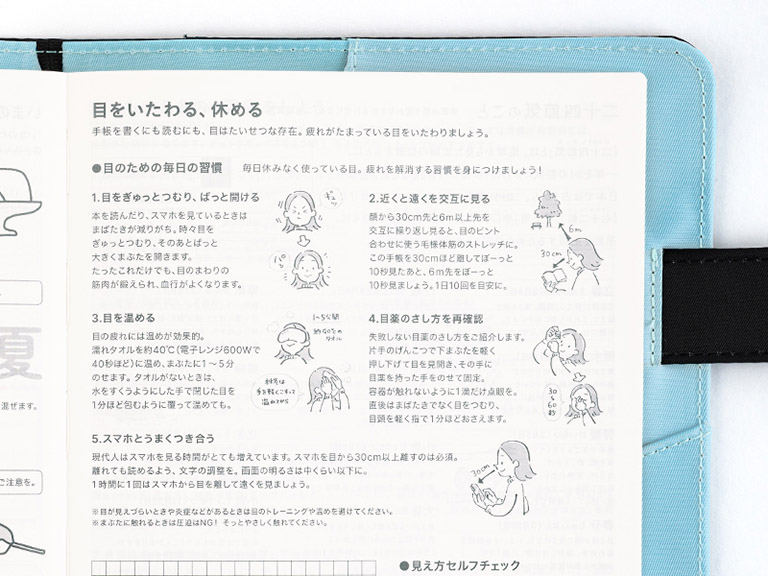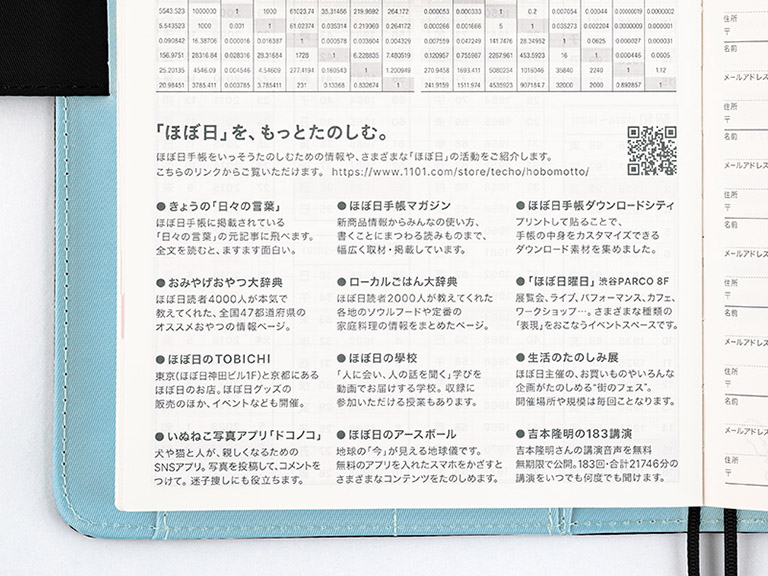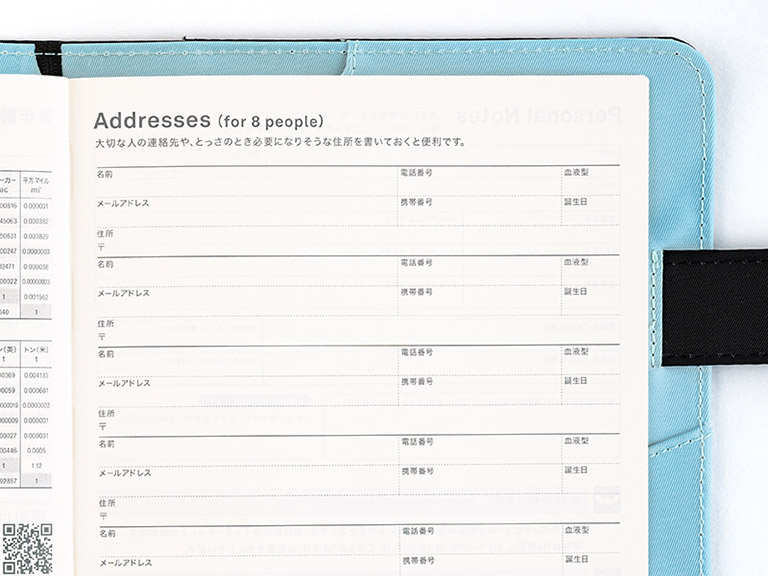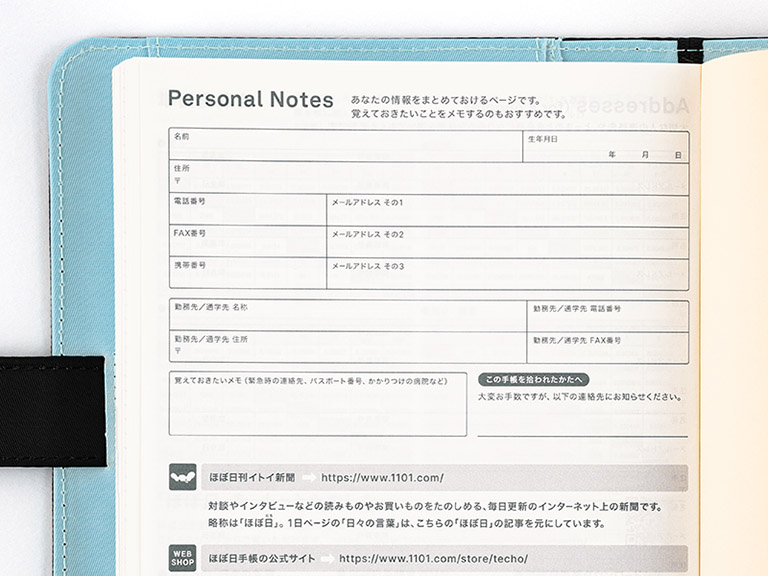- About
- Shopping
- Articles
HOBONICHI TECHO 2024 Book Buying Guide Cousin A5
- Japanese
- English
- Simplified Chinese
- Avec 2-book
- Plenty of room to write
- Weekly pages only included in the Cousin!
- Pair it with your favorite cover!
 Summary
Summary

The one-day-per-page A5-size techo was created in response to customer requests for more space to fill with writing and clippings and is designed to be paired with the A5 cover of your choice. The Cousin is perfect for collecting a great deal of information into a single book, using as a school notebook or parenting diary, or simply writing in larger letters. The larger size means this book is ideal for leaving in a single place at work or at home. The Cousin also has an exclusive section: the popular “Weekly Pages” tracks a week in each two-page spread for easy planning.

Plenty of room to write

Weekly pages only included in the Cousin!

Pair it with your favorite cover!
 Specifications
Specifications
Cover and Basic Features
![]()
Book cover
The front has a soft ivory hue, and includes the label “HOBONICHI TECHO 2024 cousin” printed in gray letters. The April-start version also lists the label “spring.”
[About the English edition Cousin book]
The name “HOBONICHI TECHO 2023 cousin” is printed in yellow letters.
![]()
A5 size is largest in lineup
The Cousin is the largest planner in the Hobonichi Techo lineup. At 148 mm x 210 mm (5.8" x 8.3"), the A5 size is twice the size of its A6 Original counterpart, so there’s plenty of room to use the Cousin for both business and pleasure.
![]()
Perfect planner paper
The book uses thin and light yet durable Tomoe River S paper. The paper has supported the Hobonichi Techo for over 20 years with its special characteristics, but it’ll be undergoing an overhaul starting with the 2024 edition techos. The paper is more resistant to bleed through, lighter despite being the same thickness, and has a smoother surface by adjusting the fibers of the paper.
![]()
180-degree lay-flat binding
Special stitch-binding allows the planner to lay completely flat without having to hold it down.
![]()
Rounded corners
The page corners are rounded to minimize creasing and damage to the edges when carried around or stored in a bag.
![]()
Serial number
Serial numbers on the inside back cover give each planner a unique identity and make your planner your very own special book.
![]()
Cousin-exclusive weekly page
The weekly page is a special section only available in the Cousin edition. It contains one week per two-page spread, with 24-hour timetables labeled 0:00 to 24:00.
![]()
New in 2024
- The "Remember This" pages and bonus pages have been updated.
Sections added in the 2024 edition
- An Interview with Myself
- Seasonal Sweets to Make at Home
- Caring for Your Eyes
Sections removed since 2023 edition
- My Favorite Things
- How to Better Enjoy Conversation
- Enjoy Learning at the Hobonichi School
- National holidays are subject to change due to law revisions.
[About the English edition Cousin book]
It contains the following bonus pages:
- Time Table
- Graph Paper
- Favorites
- My 100
- An Interview with Myself
- Seasonal Sweets to Make at Home
- Caring for Your Eyes
- Words to Remember
- 365 Days Check-Off Sheet
- Getting the Most Out of Your Hobonichi Techo
- Gifts
- Addresses
- Personal Notes
Yearly Calendar / Yearly Index
![]()
Yearly calendar
A convenient double-page spread shows the yearly calendars for 2023, 2024 and 2025 at a glance for a useful reference when planning ahead.
![]()
Yearly index
Each 2-page spread contains 6 months, with a total of 12 months in the yearly index. The top of each monthly column includes 3 checkboxes for writing goals and to-do lists, and the bottom of the page has extra space for note-taking.
Monthly Calendar
![]()
Monthly calendar
The monthly calendar is ideal for managing schedules. The graph paper design is lightly printed to make it easier to write in your plans and take notes in an even line. The blue gray and red print both allow for high visibility when writing in the calendar.
[About the English edition Cousin book]
The English edition does not list holidays.
![]()
Monthly data
Each header includes the year, numerical month, the traditional Japanese name of the month, and the English name of the month.
[About the English edition Cousin book]
The English edition does not list the traditional Japanese name of the month.
![]()
Daily boxes
Each box is lightly printed with a graph design to make it easy to fill in a full day’s worth of plans. You can also take full advantage of the graph design by drawing out sections to allocate plans or entries visually.
[About the English edition Cousin book]
The English edition does not list holidays.
![]()
Week number
The monthly calendars include the number of the week. The formula we use begins counting with the first week in January that includes a Thursday.
![]()
Free space
The calendars include free space below and to the left for taking notes, making plans or decorating the calendars with stickers and washi tape.
![]()
Moon phase
The calendars include icons depicting new moons (●) and full moons (○). (While the moon phase is the same across the world, the exact dates the moon phases land on are listed in Japan time.)
![]()
Rokuyo (Traditional Japanese calendar)
The monthly calendar days are labeled with rokuyo, a cycle of six days said to predict good or bad fortune that day. The labels are commonly found on Japanese calendars and used to plan weddings and funerals.
[About the English edition Cousin book]
The English edition does not list the Rokuyo.
![]()
Labeling 2025
The monthly pages for 2025 have the year in large numbers in the background to easily differentiate them from the 2024 pages.
Weekly Pages
![]()
Weekly pages
The Cousin contains weekly calendars that are useful for managing detailed schedules for the week. The timeline covers a full day from 5 AM to 4 AM the following day, allowing users to record any and all plans.
![]()
Monthly data
Each header includes the numerical month, the year, the traditional Japanese name of the month, and the English name of the month. The calendar also includes the number of the week.
[About the English edition Cousin book]
The English edition does not list the traditional Japanese name of the month.
![]()
Calendar and free space
The weekly page includes a mini monthly calendar at the top left of every two-page spread. Underneath it is free space for taking notes, making plans or decorating the calendars with stickers and washi tape.
![]()
Moon phase
The calendars include icons depicting new moons (●) and full moons (○). (While the moon phase is the same across the world, the exact dates the moon phases land on are listed in Japan time.)
![]()
Time line
The weekly calendar contains a time line that begins at 5 AM and ends at 4 AM the next day. Each hour consists of two lines on the grid, making it easy to write in intervals of 30 minutes.
Daily Pages
![]()
One day per page
The planner features a format with a page devoted to each day. There’s lots of open space to plan the day ahead and enjoy recording your memories and activities. Think of the pages as containers for random ideas, with a clear record of the date. Paste magazine clippings, ticket stubs and photos to make the techo something completely unique ― your imagination is the only limit.
![]()
Moon phase and day of the year
An illustration of the current moon phase is paired with the day of the year. The new moon (●) and full moon (○) symbols are surrounded by stars at their peak. (While the moon phase is the same across the world, the exact dates the moon phases land on are listed in Japan time.)
![]()
Old Japanese lunisolar calendar
The date of the old Japanese lunisolar calendar is also included under the day’s date. This calendar was used in Japan until 1873, when Japan adopted the universal Gregorian calendar. Some days in this lunisolar calendar are specified as standard days signifying the changing of the seasons. We’ve also included solar terms based on this ancient calendar.
[About the English edition Cousin book]
The English edition does not list the old Japanese lunisolar calendar and solar terms.
![]()
To-do list
The to-do list is located at the top of the page with checkboxes for keeping track of your goals for the day.
![]()
24-hour timetable
Work and personal plans take place at different times of the day, so the planner uses a full 24-hour timetable to accommodate all schedules. Each hour is labeled with a dot, and every 30-minute mark is labeled with a line.
![]()
The “Secret Line”
There’s also something we call the “Secret Line”: a vertical line that runs parallel along the right of the timetable. This separates the schedule on the left from the open memo pad on the right. We’ve printed it lightly enough that you can ignore it when using the page as a whole.
![]()
3.7 millimeter graph paper
The 3.7 millimeter graph paper was the result of extensive tests for an ideal size for writing in Japanese, although the size also allows comfortable writing in any language. Feel free to write along the lines of a single line or two ― or just ignore the lines altogether.
![]()
Japanese holidays
Japanese holidays are labeled on the bottom left corner and printed in a light ink to make it easy to write over them.
[About the English edition Cousin book]
The English edition does not list holidays.
![]()
Daily quotes
From the heartfelt to the humorous to the whimsical, each page of the planner features a quote in Japanese, specially selected from the planner’s parent site, Hobo Nikkan Itoi Shinbun.
[About the English edition Cousin book]
Each spread features quotes specially selected from the book’s parent site, Hobo Nikkan Itoi Shinbun, and translated into English.
![]()
12-color tabs
Similar to a dictionary, each month is labeled with a different colored tab on the edge of the page for easy reference, even when the book is closed. It is easy to flip ahead to write future plans, or flip back to read old pages.
![]()
Mini calendar
The daily page also includes a mini monthly calendar at the bottom right of every two-page spread. The dates of the current pages are outlined.
![]()
Turning the page
This warming-up page helps you get ready for the new year. It’s a great place to write your reflections on the past year, list your goals for the year ahead, copy down important information from last year’s planner, or do anything else you need to feel prepared.
The left and right corners of the page contain calendars for the two months surrounding the book’s initial start date.
![]()
Remember This
We’ve included a page at the beginning of each month for note-taking. It includes a seasonal compendium for everyday life with information such as foods that are in season and season-specific events for modern-day life.
[About the English edition Cousin book]
The English edition does not include the seasonal compendium.
Bonus Pages
![]()
Memo pages
The book includes blank pages in the back for capturing random thoughts, sketching or storing items of interest that aren’t time-sensitive. These pages are made with the same 3.7 millimeter graph paper design used in the daily pages.
Number of memo pages:
Full year (January start): 5 pages
Full year (April start): 6 pages
English edition (January start): 5 pages
Avec 2-Book Set (Jan-Jun): 9 pages
Avec 2-Book Set (Jul-Dec): 5 pages
![]()
Time Table
The book includes two timetables for writing in a recurring hourly schedule for each day of the week. These are useful, say, for filling in the broadcast times of favorite television shows, or splitting up house chores.
![]()
Graph Paper
The graph paper is convenient for recording your daily weight or other changes when you have a certain target in mind. The horizontal X-axis along the bottom contains 31 boxes to easily cover a one-month span, with extra space at the bottom for additional notes.
![]()
Favorites
The Favorites page is a great place to list rankings for movies, books, music, restaurants, plays, games and much more — on a sliding scale of 5 stars.
![]()
My 100
You can use this 100-item list to make a list for anything you want: things to accomplish this year, books you’ve read, movies you’ve seen, snacks you’ve tried, shops you want to visit — it’s up to you!
![]()
An Interview with Myself
This is a section for thinking about you. Fill in the answers and read them over again once in a while, and maybe you’ll discover something new about yourself.
![]()
Seasonal Sweets to Make at Home
A page with recipes of some delicious desserts by chef Shiho Nakashima to
enjoy with each season of the year.
![]()
Caring for Your Eyes
Your eyes are indispensable, not least for writing and reading your techo. This page looks at some ways to look after your eyes when they are tired. It also comes with an image to check your vision.
![]()
Solar Terms (Japanese)
This section explains the names and origins of solar terms that make up the 24 points in traditional East Asian lunisolar calendars. These include well-known days such as the start of spring and the winter solstice.
[About the English edition Cousin book]
This page is not included in the English edition book.
![]()
Emergency Preparedness (Japanese)
This page contains a checklist of items to have ready in case of an emergency. There is also a space to list nearby evacuation zones (common in Japan), emergency contact information and topics discussed between family and friends.
[About the English edition Cousin book]
This page is not included in the English edition book.
![]()
Words to Remember
[About the English edition Cousin book]
This page is exclusive to the English edition. You can write down phrases and words you encountered throughout the year that you want to read back on or avoid forgetting. Use the shaded area to write down dates or citations.
![]()
365 Days Check-Off Sheet
[About the English edition Cousin book]
This page is exclusive to the English edition. This page has a bubble you can fill in for each day of the year. Use it to track studying, working out at home, or anything else you’d like to do every day. Let this check-off sheet help you stay motivated and achieve your goals!
![]()
Gifts
Record the presents you’ve given or received in the Gifts page so you don’t forget who gave what to who and when. This is also helpful for thank-you cards. There are spaces for 20 entries.
![]()
Age Table (Japanese)
This table lists the year people were born, and their age in 2024 at a quick glance. The number to the left of the year is the corresponding year based on the traditional Japanese Imperial Era calendar, and to the right of their age is the character for the Chinese Zodiac. Highlighted years have the same Chinese Zodiac as 2024 (Year of the Dragon).
[About the English edition Cousin book]
The English edition does not include this bonus page.
![]()
Conversion Table (Japanese)
This chart features conversions between units of measurement for easy reference and calculation.
[About the English edition Cousin book]
The English edition Cousin does not include this bonus page.
![]()
Getting the most of Hobonichi (Japanese)
This page includes information to further enjoy your Hobonichi Techo and an introduction to what Hobonichi does. Also contains a link to a list of Japanese articles the quotes are selected from.
[About the English edition Cousin book]
The English edition is titled “Getting the Most Out of Your Hobonichi Techo” where you can discover all kinds of ways to have fun with your techo.
![]()
Addresses (for 8 people)
The address book allows you to write in the contact information for up to 8 people, such as family and close friends.
![]()
Personal Notes
Be sure to enter your contact information on the Personal Notes page in the back of your planner in case it’s misplaced.
Avec Two-Book Set
![]()
Compact 6-month book avoids bulk
The Avec, which means “together” in French, contains a January-June book and a July-December book. These books are ideal for filling to the brim with contents, as the slim size gives users a great head start on keeping the book at a manageable thickness. The light weight also makes it comfortable for carrying around.
*No Spring (April-start) version available.
![]()
Cover
The covers are matched with a color scheme of lime yellow and ice blue. The spine tape is a reddish-brown to give the color scheme a unique look.
![]()
Half the weight and thickness
The Avec contains 288 pages, making its carefully-balanced weight and thickness just over half of the 544-page full version.
![]()
Includes bonus pages
Book 1 and Book 2 of the Avec both include the same extra pages in the back and only vary in the number of pages included. So if you’re tracking anything on a graph, for example, it’s easy to continue that same pattern in the next book.
![]()
Fits standard Hobonichi Techo covers
The Avec fits neatly into the standard Hobonichi Techo covers. It also leaves plenty of room to couple it with your favorite notebook if you fit only one side of the Avec book cover into place.

